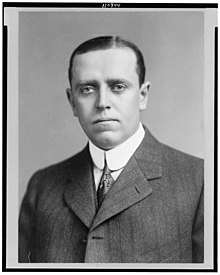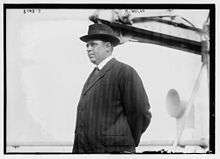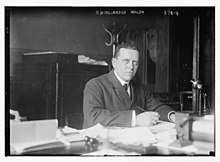Rhinelander Waldo
Rhinelander Waldo (May 24, 1877 – August 13, 1927) was appointed the seventh New York City Fire Commissioner by Mayor William Jay Gaynor on January 13, 1910. He resigned on May 23, 1911, less than two months after the deadly Triangle Shirtwaist Factory fire to accept an appointment as the eighth New York City Police Commissioner. On December 31, 1913, he was dismissed by the outgoing acting mayor, Ardolph Kline. Among other achievements in office, Waldo contributed to the motorization of both departments.
Rhinelander Waldo | |
|---|---|
 Waldo c. 1908 | |
| 8th New York City Police Commissioner | |
| In office May 23, 1911 – December 31, 1913 | |
| Appointed by | William Jay Gaynor |
| Preceded by | James C. Cropsey |
| Succeeded by | Douglas I. McKay |
| 7th New York City Fire Commissioner | |
| In office January 13, 1910 – May 23, 1911 | |
| Appointed by | William Jay Gaynor |
| Preceded by | Nicholas J. Hayes |
| Succeeded by | Joseph Johnson |
| Personal details | |
| Born | May 24, 1877 New York City, New York, U.S. |
| Died | August 13, 1927 (aged 50) Garrison, New York, U.S. |
| Spouse(s) | Virginia Otis Heckscher
( m. 1910; |
| Parents | Francis William Waldo Gertrude Rhinelander Waldo |
| Alma mater | Columbia University School of Mines United States Military Academy |
Early life
Rhinelander Waldo was born on May 24, 1877 in New York City to Francis William "Frank" Waldo, a stockbroker who died in 1878, and Gertrude Rhinelander Waldo, an American heiress known for commissioning the Rhinelander Mansion located in Manhattan at 867 Madison Avenue on the south-east corner of 72nd Street, designed in the 1890s by Kimball & Thompson and completed in 1898.[1]
Waldo was educated at the Berkeley School and the Columbia University School of Mines before attending the United States Military Academy at West Point.[2]Columbia University's alumni notes show that he was a member of the class of 1899, but it was unsure whether he graduated with the class or not.[3]
Career


He joined the Seventeenth Infantry Regiment of the United States Army as a Second Lieutenant in 1899, after the United States had occupied the Philippine Islands in the Spanish–American War. In the course of nearly four years in the Philippines, he served under General Arthur MacArthur, Jr., was on the staff of General Leonard Wood during the Moro rebellion, and commanded a battalion of Philippine Scouts. He resigned from the Army in 1905 with the rank of Captain, and became New York's First Deputy Commissioner of Police in January 1906, at the age of 28.[4]
Waldo, who had served as New York City Fire Commissioner since the beginning of Mayor Gaynor's term in January 1910,[5] was in office at the time of the Triangle Shirtwaist Factory fire which occurred on March 25, 1911 and killed 146 people.[6]
On June 9, 1911, only 17 days after taking office as Police Commissioner, Waldo founded the motor-cycle squad, organized under the Office of Street Traffic Regulation Bureau.[7] Another of his early acts as Police Commissioner was the appointment of three "Strong Arm" anti-vice squads and their commanders—one of whom, Charles Becker, was later executed for complicity in the July 1912 murder of the bookmaker Herman Rosenthal (shortly after Rosenthal had told the press of extortion by Becker and other police).
Acting Mayor Ardolph Kline's elected successor, John Purroy Mitchel, indicated before taking office at noon on January 1, 1914, that he would not keep Commissioner Waldo in office. Waldo tendered his resignation effective at midnight December 31, 1913, after transferring or accepting resignations from most of the department's senior officers and specialists. Amid much confusion and discord, Mayor Kline (who had taken office after Mayor Gaynor's death in September 1913)[8] refused to accept Waldo's resignation (which would have left the Department without leaders for the first 12 hours after New Year's Eve) and fired him instead.[9]
Later career
In 1916, Waldo held a commission as Major in the Infantry Officers Reserve Corps. He went into World War I as a Major in the 301st Infantry of the National Army in 1917. After serving in France, he was honorably discharged in 1919 and in 1923 was commissioned a Colonel in the reserve.[10]
After he was out of office, he stayed involved with political affairs and while Richard Enright was New York City Police Commissioner (appointed by the regular Democratic Mayor John Francis Hylan), Waldo served for a time as a special deputy but resigned in September 1924 to organize the Coolidge Nonpartisan League, a step that "marked his formal renunciation of Tammany Hall in favor of the Republican Party."[10] Around this time, he was mentioned as a possible candidate for Governor General of the Philippines.[10]
Personal life
On April 20, 1910, he was married to Virginia Otis Heckscher at the country house of artist Charles H. Ebert in Greenwich, Connecticut.[2][11] Virginia, a daughter of Robert M. Otis and Helen (née Gordon) Otis of Richmond, Virginia, was twice widowed before their marriage. Her second marriage was to John Gerard Heckscher who died in 1908 (he was the widow of Mary (née Travers) Gray, a daughter of William R. Travers, and the father-in-law of Mayor George B. McClellan Jr.).[12]
He died on August 13, 1927 in his home in Philipse Road in Garrison, New York of sepsis.[10]
In popular culture
Waldo was portrayed by James Cagney in the 1981 film Ragtime, despite the age difference (Cagney was 81 years old when he filmed this movie; the real Rhinelander Waldo was only 32 at the time in which the movie was set and died at age 50.) However, in E.L. Doctorow's original 1975 novel Ragtime from which the film was adapted, Waldo's role in the narrative is minor while Charles S. Whitman, the real-life Manhattan District Attorney at the time, performs most of the fictional words and deeds that the film would later assign to Waldo.
See also
- Philippine–American War (then known in the U.S. as the "Philippine Insurrection")
- Moro Rebellion
- New York Police Department
- Fire Department of New York
- Ragtime – A 1981 motion picture (based on the novel by E.L. Doctorow) featuring a fictionalized Rhinelander Waldo portrayed by film legend James Cagney in his last role in a feature film.
References
- Gray, Christopher (7 October 2010). "From a Mysterious Mansion to a Ralph Lauren Store". The New York Times. Retrieved 21 January 2020.
- "WALDO TO MARRY MRS. J.G. HECKSCHER; Fire Commissioner's Marriage to Third Wife of Late J.G. Heckscher to Occur To-morrow" (PDF). The New York Times. 19 April 1910. Retrieved 21 January 2020.
- Columbia Alumni News. Alumni Council of Columbia University. 1919.
- "RHINELANDER WALDO IS FIRST POLICE DEPUTY; Was a Captain in the Regular Army -- Only 30 Years Old. APPOINTMENT A SURPRISE New Deputy Made a Good Record in the Philippines -- Is a Cousin of Lispenard Stewart" (PDF). The New York Times. 24 January 1906. Retrieved 21 January 2020.
- "GAYNOR PUTS WALDO IN CROPSEY'S PLACE; Tells Him to Banish Favoritism from Police as He Did from Fire Department". The New York Times. 24 May 1911. Retrieved 21 January 2020.
- "141 MEN AND GIRLS DIE IN WAIST FACTORY FIRE; TRAPPED HIGH UP IN WASHINGTON PLACE BUILDING; STREET STREWN WITH BODIES; PILES OF DEAD INSIDE; The Flames Spread with Deadly Rapidity Through Flimsy Material Used in the Factory". The New York Times. 26 March 1911. Retrieved 21 January 2020.
- "Indian" brand Motorcycle Exhibit Archived 2009-03-19 at the Wayback Machine at the New York Police Museum -- retrieved on June 20, 2008.
- "MAYOR STAYS AWAY FROM WALDO DINNER; Much Comment Among 600 Guests at Testimonial to Commissioner. NO EXPLANATION GIVEN Mr. Kline Was Chairman of Committee That Arranged Function and Was to be Toastmaster". The New York Times. 30 December 1913. Retrieved 21 January 2020.
- Kline Ousts Waldo; Calls Him Childish – Willing to Break Down Police Department to Satisfy His Pique, Mayor Writes. The New York Times, Thursday, January 1, 1914, page 1, retrieved on June 20, 2008, beginning "Rhinelander Waldo was summarily dismissed from office as Police Commissioner yesterday by Mayor Kline. The removal came as the climax of a series of complications that had kept the department in a turmoil ever since it became definitely known that Mayor-elect Mitchel intended to let Waldo go and appoint a Police Commissioner of his own choosing."
- "COL. WALDO, 50, DIES OF SEPTIC POISONING; Former Police and Fire Head Succumbs at Garrison, N. Y., of an Old Ailment. SERVED IN THE PHILIPPINES Arduous Labors There Blamed for Fatal Illness--Storm Centre While In Office Here" (PDF). The New York Times. 14 August 1927. Retrieved 21 January 2020.
- "WALDO WEDS MRS. HECKSCHER; Fire Commissioner Married to Widow of Late John G. Heckscher" (PDF). The New York Times. 21 April 1910. Retrieved 21 January 2020.
- "J.G. HECKSCHER AT 70 WEDS A YOUNG WIDOW; Mrs. Virginia Otis the Third Wife of the Mayor's Father-in-Law. KEPT IT SECRET FOR A YEAR Mr. Heckscher's Duel with Henry Winthrop Gray and His Marriage to Mrs. Gray Recalled" (PDF). The New York Times. 20 October 1905. Retrieved 21 January 2020.
External links
- Photographic portrait of Rhinelander Waldo from about 1908 retrieved on June 20, 2008
- Original (TIFF or QuickTime) of the same image from the Library of Congress.
| Fire appointments | ||
|---|---|---|
| Preceded by Nicholas J. Hayes |
New York City Fire Commissioner 1910–1911 |
Succeeded by Joseph Johnson |
| Police appointments | ||
| Preceded by James C. Cropsey |
New York City Police Commissioner 1911–1913 |
Succeeded by Douglas I. McKay |